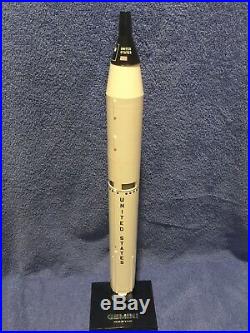
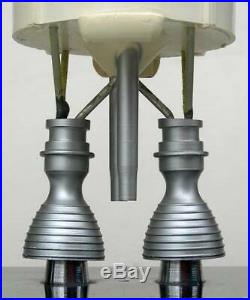



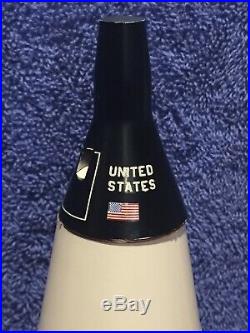
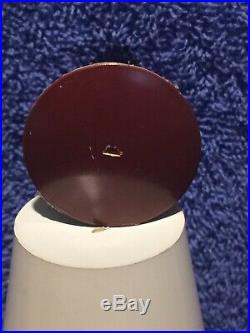
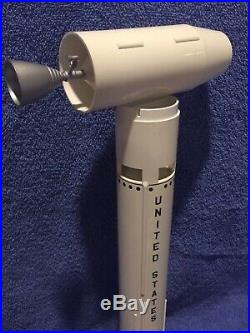
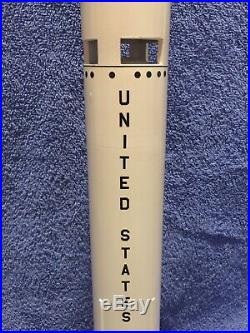
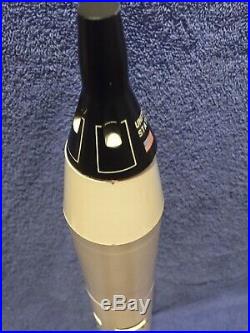



Thank you for viewing our listings. All of our items are from our closed aviation art gallery or museum, or from our own extensive personal estate collection. Offered for your consideration is an original 1960’s Topping GEMINI-TITAN ROCKET MODEL in very good condition. Note the manned capsule on top sits losely, since the tiny connector tab between rocket and capsule broke off long ago. Not noticible when displayed, and can be repaired. Please view all photos. International buyers are welcome. Too, was quick to recognize the vehicle’s capabilities and ordered a modified version of the Titan II to launch its two-person Gemini spacecraft. Ten crewed Gemini missions were launched during 1965 and 1966 from Cape Canaveral, developing the techniques required for the upcoming Apollo Moon landing program. The model of the Gemini-Titan rocket, shown here, was made by Topping; there are some differences in this launcher from the basic Topping ICBM Titan II model. Project Gemini, pronounced “Jiminy” (cricket)by the astronauts, which used a two-man spacecraft, bridged the gap between the Mercury program, the first tentative steps into space, and the Apollo program, which landed men on the moon. Gemini’s primary objectives were to investigate the problems of long-duration spaceflight, to develop techniques for rendezvous and docking with target vehicles, and to conduct extravehicular operations. After two unmanned test flights in 1964, ten manned Gemini missions took place in 1965-66. Two of these, Gemini 6 and 7, were simultaneous so that the capsules could rendezvous in space and orbit in close formation. The Gemini capsule, the diminutive model shown below, weighs approximately 4,500 pounds and is 8 feet, 6 inches tall. Sixteen different astronauts made Gemini flights and four others trained for them. This experience was passed on to Apollo, as 15 of the 20 men subsequently flew in the lunar program. The rapid succession of Gemini missions demonstrated that it was truly a second generation spacecraft, and the length of its missions – 330 hours on Gemini VII – allayed major medical concerns over man’s ability to adapt to and function in space. More and more it became an accepted fact during Gemini that man could, should, and would fly to the Moon and back. An insight by a space engineer: As Project Mercury came to an end, many members of the Aerospace Mercury-Atlas team transitioned to the next space initiative, Project Germini. A member of that team, in an interview, when questioned about the difference between the Mercury and Gemini, stated, I think it was probably easier. The Titan II was a pretty robust design as opposed to the Atlas. We were dealing with later technology. We weren’t dealing with the structural problems that Atlas could encounter with a thin skin, and we had some working knowledge now of an abort system. We knew how to build an abort system, and we knew how to engineer an abort system that would detect malfunctions during ascent. So the task of getting a malfunction detection system into the Titan rocket was, I believe, simpler and we learned a lot from the Mercury Program so it made the job a little easier. We found some vulnerabilities in the Titan by going back, and we reviewed every Titan flight that had ever flown. And at that time, I can’t remember the numbers, but there were many, many dozens of Titan failures that had occurred. We went through every Titan failure and made a determination whether the failure had been identified and been fixed on the Titan weapons systems fleet. If it hadn’t, we carried that problem to the Gemini Program and then a review board looked at every single flight failure that hadn’t been fixed or explained to see if there was something we should do to the Gemini rocket to make it more reliable. And one of things we discovered is that we needed to put in a redundant first stage flight control hydraulic actuator system. We had dual actuators steering engines as a result of hydraulic failures that had occurred previously. So we made a lot of modifications to the Titan II rocket to make it more reliable based on that flight history. Concerning the absence of an escape tower on the Titan II , Wambolt said, The mission malfunction detection system that was used on the Gemini was different in that we had no escape tower. But we had developed a malfunction display panel in the satellite itself, or in the spacecraft, and the crew had the ability to shut down the rocket, eject, or abort. Or they could switch back to our flight control system if it turned out that our system malfunctioned early in flight and was corrected. And if it corrected itself and they switched back to the primary mode, they had an ability to switch over to a backup mode. So we had a much more sophisticated abort protection system, or malfunction detection system, for Gemini than we did for Mercury. The crew became, as I remember now, much more integrated into the process of whether or not they would abort the mission. It was almost out of their control on Mercury. It was pretty much in the control of the ground NASA mission operational people whether they should abort on Mercury. But on Gemini the crew had enough onboard instrumentation to make their own determination where they were in trouble during booster ascent with the data provided, and they could decide whether or not the situation was critical [enough] to abort or whether to continue with the mission. Wambolt, when questioned about the need for the Gemini program, said, In terms of the U. Space program, I would have to yield to NASA on that because I know NASA, the people that we worked with, felt that Gemini was a necessary stepping-stone to Apollo. There were too many unanswered questions about whether EVA [extravehicular activity] was going to be safe. Whether or not Gemini could rendezvous safely with another vehicle in space. Whether or not they could penetrate the altitude in the long duration necessary for some of these future missions. As I recall, the Gemini Program was the first to come up with 14 days in orbit, and the nature of the medical effects on the astronauts was unknown at that time. The ability to think and provide reasonable conclusions if they encountered an on-orbit malfunction-could the crew in the space environment continue to operate and think properly under those conditions? Was the mission control concept of having a mission control in Houston watching and overseeing the flight, was that network ready to take on a mission like the mission to the Moon and the duration of the crews and so forth? Because the time between the earth and the moon essentially was what a Gemini mission was. It was tailored to be a mission to the moon. So a lot of knowledge needed to be obtained by the spacecraft community. It didn’t affect the booster folks ourselves. We didn’t notice the difference as far as Gemini versus Mercury. It was strictly a stepping-stone in space for us, going from one rocket to another. But it was a huge step for NASA to make. I don’t think NASA would have ever made that step from a one-man capsule to a three-man module for the Moon without Gemini. I really think Gemini was vital to the whole Moon program. I would doubt you would find anyone at NASA who would disagree with that. As described, as always, beautiful kits! Entire order arrived in perfect condition! Thanks for this, yet, third order! A rare item from a rare breed of dealer – Absolutely thrilled with this! Great antique display model. Great to deal with; recommended for repeat dealing. TOP NOTCH EBAYER – JUST THE WAY IT SHOULD BE – THANKS AAA++++. OUTSTANDING item, extremely well-packed. Arrived three days ahead of schedule! All in good order! I’ll be back! Super models, great packing and communication. Well packed, item arrived safe and very pleased. ALWAYS a pleasure dealing with “collectair”. The item was just as described and carefully packaged. Great to do business with. Arrived in perfect condition. In great shape for 1938 kit. We value our customers and appreciate the courtesy of making things right before leaving neutral or negative reviews should a need arise. Pictures are worth a thousand words. Please view them carefully. Need more pictures of the item? We are pleased to provide additional photos. What you see is what you will receive. If its not in the photos, it is not included. We do our best to fairly and accurately represent our items, but in some cases due to the rarity of the item or its age and condition, little information may be available. We do not inventory our kits, or open sealed items or antiques for completeness unless noted as such in our listings. These are estate sale items and presented in the condition found. If you would like to insure your item please let us know before paying. Please put the items in your basket and ask for an invoice. The item “Topping GEMINI-TITAN ROCKET MODEL FREE SHIPPING” is in sale since Saturday, April 11, 2020. This item is in the category “Toys & Hobbies\Models & Kits\Rocketry”. The seller is “collectair” and is located in Maryville, Tennessee. This item can be shipped to United States, Canada, United Kingdom, Denmark, Romania, Slovakia, Bulgaria, Czech republic, Finland, Hungary, Latvia, Lithuania, Malta, Estonia, Australia, Greece, Portugal, Cyprus, Slovenia, Japan, China, Sweden, South Korea, Indonesia, Taiwan, Thailand, Belgium, France, Hong Kong, Ireland, Netherlands, Poland, Spain, Italy, Germany, Austria, Bahamas, Israel, Mexico, New Zealand, Singapore, Switzerland, Norway, Saudi arabia, United arab emirates, Qatar, Kuwait, Bahrain, Croatia, Malaysia, Chile, Costa rica, Panama, Trinidad and tobago, Guatemala, Honduras, Jamaica, Bangladesh, Bermuda, Brunei darussalam, Bolivia, Egypt, French guiana, Guernsey, Gibraltar, Guadeloupe, Iceland, Jersey, Jordan, Cambodia, Liechtenstein, Luxembourg, Monaco, Macao, Martinique, Maldives, Nicaragua, Pakistan, Paraguay, Reunion, Uruguay.
- Modified Item: No
- Country/Region of Manufacture: United States
- Custom Bundle: No
- MPN: Does Not Apply
- Character Family: rocket
- Brand: Topping
